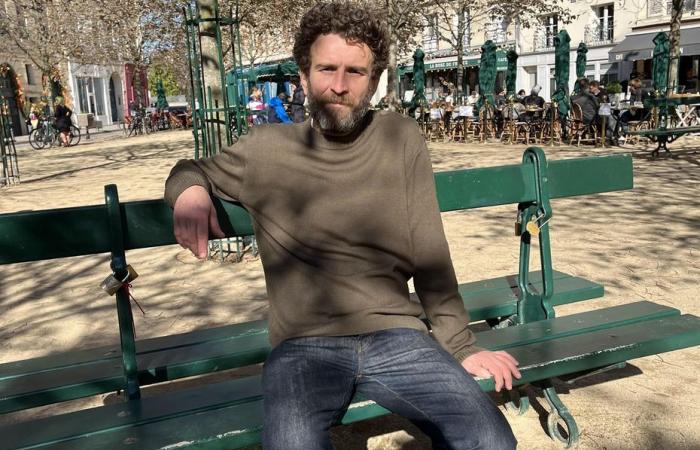
In everyday life, Vincent Periat is a florist. Whenever he has free time, he wanders around Paris and takes notes wherever he goes. From his walks, he created a book of unusual maps. Meeting with a Parisian asphalt adventurer.
The essentials of the day: our exclusive selection
Every day, our editorial team reserves the best regional news for you. A selection just for you, to stay in touch with your regions.
France Télévisions uses your email address to send you the newsletter “Today’s essentials: our exclusive selection”. You can unsubscribe at any time via the link at the bottom of this newsletter. Our privacy policy
Taking a stroll through Paris with Vincent Périat is a bit like opening a history book that is constantly in motion. On every street, he has a new anecdote to share. Each building is a pretext to tell the small and big story that goes with it.
Every Friday he travels “mostly on foot” in the capital to explore its historic streets. In the Marais district, he stops short in front of walls which today serve as the facade of a high school. “In the Middle Ages, the walls formed fortifications with the enclosure of Philippe Auguste. At the time, it was used to protect Paris. There were protective enclosures from Antiquity until the 19th century “, he says.
Ancient medieval fortifications in Paris.
•
© France 3 Paris Île-de-France
He has been roaming the city of Paris with his backpack and sneakers for several decades. Arriving in the capital at the age of 22 for his studies, this forty-year-old drew from his strolls a collection in which he lists 100 cards “to see Paris differently“These maps are the subject of his first book: “Atlas Inutile de Paris” published by Le Tripode. “This book is the result of 10 years of work and walks, I explore each neighborhood as others would explore a desert island.”
Looking for curiosities in this city that fascinates him. While some maps may appear to be of public utility, such as the neighborhood-by-district trash collection map, others are more unexpected, such as the cowshed map in Paris.
The map of Vacheries in Paris before 1895.
•
© Editions Le Tripode
“These are the stables and dairies which appeared in Paris before 1895 and made it possible to extract milk from cows.“, specifies the author. On a daily basis, he is a florist in Saint-Denis. He writes his story of Paris in his free time. “I read a lot. In particular, I spend a lot of time at the Historical Library of the City of Paris.”
Continuing further, we discover the Hôtel de Sens with him. “The monument is known, but we know that at the beginning of the 20th century, it was located in an unsanitary islet. This is where cases of tuberculosis were recorded and patients placed until they were cured. I made a map of it too.”
The Hôtel de Sens was located in an unsanitary island at the beginning of the 20th century.
•
© France 3 Paris Île-de-France
A haunted house in the heart of Paris
The book is always structured in the same way: a map and a few sentences in the caption on each page to explain the subject. “Some maps require explanations, because they need context, like those of haunted houses and ghosts in Paris.” After going around the Marais, he slows down and lowers his voice.
“We soon arrive in front of a haunted house,” he told us calmly as we approached rue de Bièvre. According to legend, this house experienced “a curse that pursued a family for generations“, says the author in a passionate tone.
Hubert’s house, a haunted house in the heart of Paris.
•
© France 3 Paris Île-de-France
The former design student has cultivated this fascination for the capital from a very young age. “My grandfather gave me a passion for Paris and its history. As a child, I lived in Auvergne, he had lived in Yvelines and when he took me there, we always passed through Paris where he told me lots of anecdotes“, remembers the florist.
Vincent Périat is not a historian. His work is the result of years of personal research and curiosity. “I do not intend for this book to be taken seriously. Moreover, there may be some errors in location and details. This is a book for anyone curious about the History of Paris. Anyone can have access to the sources I consulted. It just takes time and curiosity.”
Time that he allows himself outside of his working hours. “Whenever I can, I take the time to admire Paris, which I always want to know more about.“, he told us, scanning Île-Saint Louis in the distance. “It is one of those islands that remain in Paris even though many have disappeared over the centuries. Île Saint-Louis was born from the merger of what was called Île aux Vaches and Île Notre-Dame in the Middle Ages. he explains.
While crossing the Pont Marie, he stops again to contemplate a plane tree.
“It seems like an ordinary tree, but according to my accounts, it’s the one we find most often in Paris“, assures the botany professional. One of his cards is also dedicated to trees in Paris.
Plane trees are the most common trees in Paris according to the florist’s map.
•
© Editions le Tripode
This book retraces 10 years of walks in Paris. In the future, he sees himself repeating this work in another city. “My friends tell me that this ‘Useless Atlas’ is available in many big cities, so why not do that elsewhere in Europe“, he concludes, sitting on a bench. And it’s not just any bench. This bench is at the geographical center of Paris. A central point which also has its own map in the pages of “l’ Useless Atlas of Paris.





